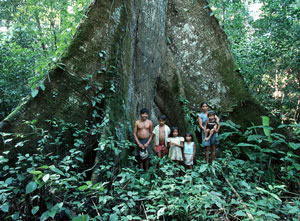The expansion of the forest industry is inevitable in Guyana given the desire for development among Amerindians, according to the Guyanese Minister of Amerindian Affairs.
"In my interactions with the [Guyanese Amerindian] communities I have found that they, like everyone else, want to move from basic survival to an improved life," said the Honourable Carolyn Rodrigues, one of the ministers attending the opening of the 39th session of the International Tropical Timber Council.
"They want better homes, better education, better health facilities, better transportation, electricity and telephones."
Guyana has a population of less than a million people and almost 75% of its land area is forested. Most of the 70,000 indigenous people, called Amerindians, live in or near the forest.
The desire for economic development will see the forests come under increasing pressure in the future, said Ms Rodrigues. With export revenue from sugar declining and fuel prices rising – making the transportation of basic goods to remote communities by aircraft prohibitively expensive – the government is looking to improve or establish road networks to facilitate development. This will increase the accessibility of the forests to commercial operations and possibly lead to over-harvesting and clearing.
"These are the hard decisions a government has to make – whether you leave the forest intact and let the people starve," she said.
Some communities with easy access have already over-exploited their forests, she said.
"Some communities have had their forests raped and I truly believe it is not because they have lost their responsibility to the environment but because they face conditions which force them to engage in unsustainable practices. How do you tell a man to save a tree when he has several pairs of eyes looking at him and they need food? We therefore need to find creative ways where people feel they are part of the development process."
Ms Rodrigues noted that the 370,000-hectare Iwokrama Forest, which was established in 1989 and has been supported by a major ITTO project, provides a model by which Amerindian communities can benefit from forest use and also maintain their leadership role in forest conservation – more than 70% of the staff is local.
In the Iwokrama Forest, about half of the area has been zoned as 'wilderness' and is not to be harvested for timber, and about half zoned for commercial logging and forest management. Ms Rodrigues said that the initiative had been a pioneer in participatory processes.
"It is a good example of how partnerships can be built and local buy-in into the project can be achieved. All 15 of the Amerinidian communities surrounding the reserve and the lone community within the reserve have all indicated that they are in full support of Iwokrama."
She appealed to delegates to continue their support for the Iwokrama initiative.
More information about the Iwokrama Forest can be found in Tropical Forest Update 15/2. For more information on the Council session go to www.itto.or.jp.
Demand for development will affect Guyanese forests - Minister
7 November 2005, Yokohama, Japan

Photo: Fotonatura